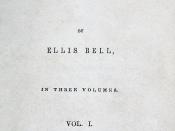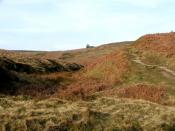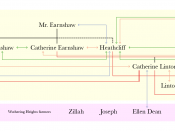A good essay about the setting of the novel Wuthering Heights by Emily Bronte. The teacher liked it enough to accuse me of cheating. :)
In Wuthering Heights, Emily Brontë makes use of atmospheric conditions to emphasise events and highlight the mood of the characters in the story. The Yorkshire moors are known for their harsh beauty and sometimes desolate landscape. This theme of a rough countryside filled with hidden beauties and seasonal storms fits well into the storyline of Wuthering Heights.
The title of the novel and the name of the Earnshaw's dwelling is used by Emily Brontë's to project the overall mood of the book. She herself writes that the word 'Wuthering [is] a significant provincial adjective, descriptive of the atmospheric tumult to which its station (the Earnshaw house) is exposed in stormy weather' (p.2).
Many of the notable events that take place between Wuthering Heights and Thrushcross Grange are accompanied by a change in the weather.
Emily Brontë uses the weather to show the beginning of a transition from calm to turbulent events in the storyline. The books starts with Lockwood's arrival, a severe winter storm raging outside foreshadows the unfriendly environment he is about to enter and the chaotic events that he is going to witness through Nellie's story telling. When Nelly begins to tell the story of the two neighbouring households, she describes Old Mr. Earnshaw setting out to Liverpool on a 'fine summer morning' (p.34). Yet, when Old Mr. Earnshaw dies she relates that 'A high wind blustered round the house, and roared in the chimney; it sounded wild and stormy' (p. 41).
Emily Brontë often uses the weather to accentuate the personality traits and moods of the characters throughout the novel. The countryside's sometimes savage weather compares well to Heathcliff's temperament. Heathcliff...


